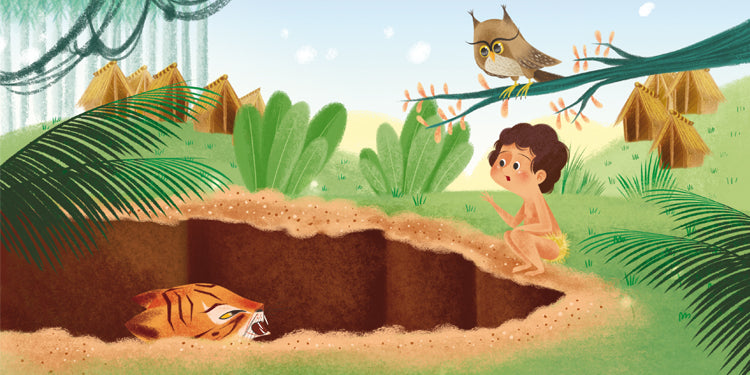 This is a guest blog post by Dr. Geraldine Haggard, who
is a retired teacher, Reading Recovery teacher leader, author, and university teacher.
It is the third and last post in a series about utilizing book introductions to help guided reading groups develop their reading strategies. To read the first post (introduction),
click here
. To read the second post,
click here
.
This is a guest blog post by Dr. Geraldine Haggard, who
is a retired teacher, Reading Recovery teacher leader, author, and university teacher.
It is the third and last post in a series about utilizing book introductions to help guided reading groups develop their reading strategies. To read the first post (introduction),
click here
. To read the second post,
click here
.
This blog series focuses on the importance of book introductions in guided reading groups. Today, I will conclude this series by examining a Level I book,
The Ungrateful Tiger
, and provide an opportunity for teacher reflection after giving a book introduction to guided reading groups.
BOOK THREE: THE UNGRATEFUL TIGER
Series: Fables and the Real World. Guided Reading Level: I (i). Genre: Fable.
PREPARATION:
- You might want to remind the children of the definition of a fable.
- The word "ungrateful" has both a prefix and a suffix. The multi-meaning word 'fair' is also a key word throughout the story and the group needs to understand what it means in the story.
INTRODUCTION:
- Distribute the books. Ask the children to notice the word in green at the top of the front cover. Remind them of a fable that you know they are familiar with and how it teaches a lesson. Explain that this book does the same thing.
- Read the title to the children. Ask them to frame the first and last syllables and find that 'un' means 'not' and 'ful' means 'full.’ They can predict that 'ungrateful' means 'not being full of thanks.’
- Ask the children to study the pictures and meet the main characters in the story (the boy, the tiger, and the owl).
- Ask the children to turn to page 8 and study the picture and frame the word 'pounced.’ How does the picture help them determine the meaning of 'pounced’? Remind them that the pictures can provide clues for meaning as they read the story.
- Remind the students that they should think about this fable’s lesson while they read. Who learned the lesson? Remember to discuss this question after the first reading.
FOLLOW-UP ACTIVITIES:
- After the first reading, a second reading could be done as a reader's theater. The teacher can be the narrator and students read the conversations of the men, the tiger, and the owl. This reading can demonstrate knowledge of traits and emotions of the characters.
- The book also is a good tool for discussing cause and effect. Why did the men dig the pit? Why did the tiger cry for help? Why did the boy help the tiger out of the pit? What happened because the boy got the tiger out of the pit? Why did the owl know what was happening between the boy and the tiger?
- You can read another fable to the children or provide fables that they can read with 95 percent accuracy or better. Children can also share a fable they read in the past and why it was a fable.
SOME CLOSING THOUGHTS FOR TEACHER AFTER THE FIRST READING
- Do you think your introduction helped the children more fluently use a strategy they are developing or use a new strategy for the first time?
- Was the reading rate appropriate?
- Did the children exhibit some feelings or facial and vocal emotions that demonstrated their understanding of character emotions? Did they use the punctuation marks as clues to understanding the character traits and feelings?
- Did the students demonstrate a need for a reading strategy that you didn’t introduce? Think about that strategy as you plan the introduction of the next book.
- Remember that multiple readings of a book are important. The students can reread the book at home. The book can be placed in the class library for even more readings. Help your parents understand the importance of the re-readings.
As you use carefully planned book introductions, you will find your readers improving their use of strategies and becoming more independent readers. Selecting just the right book and identifying what support the group needs to read a new book will help students improve their reading strategies, fluency, and reading rate.
Geraldine Haggard is the author of several books from our Kaleidoscope Collection . She spent 37 years in the Plano, TX school system. She currently tutors, chairs a committee that gifts books to low-income students, teaches in her church, and serves as a facilitator in a program for grieving children.
~~~
Click the left image below to download an information sheet with key features about Fables and the Real World , which contains the book featured in this article.



















































![6 Fun and Easy Activities to Practice Sequencing [Grades K-1]](http://www.hameraypublishing.com/cdn/shop/articles/Red_Typographic_Announcement_Twitter_Post-5_bf1ae163-a998-4503-aa03-555b038d1b76_600x.png?v=1689961568)
![Leveraging Prior Knowledge Before Writing and Reading Practice [Grades 1–2]](http://www.hameraypublishing.com/cdn/shop/articles/Red_Typographic_Announcement_Twitter_Post-4_600x.png?v=1689961965)